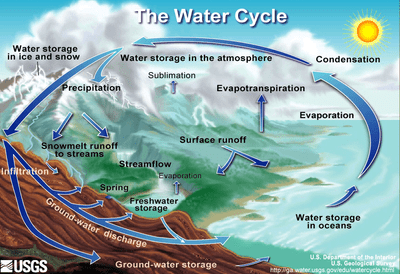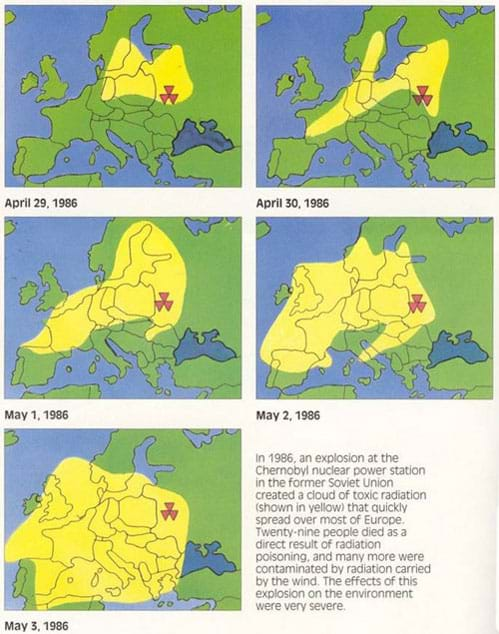Quick Look
Grade Level: 5 (4-6)
Time Required: 45 minutes
Lesson Dependency: None
NGSS Performance Expectations:

| 5-ESS3-1 |

Summary
Looking at models and maps, students explore different pathways and consequences of pollutant transport via the weather and water cycles. In an associated literacy activity, students develop skills of observation, recording and reporting as they follow the weather forecast and produce their own weather report for the class.Engineering Connection
Air, water and soil pollution do not stay in one place, so understanding the weather and water cycles helps environmental engineers explore the human impact from pollutant transport. Many engineers are employed solely to research, design and implement procedures that minimize pollution. They help to clean up acid rain, ozone holes, ground water contamination, emissions, and global warming, by modifications in design, manufacturing, regulations and practices that clean up many problems and make our living environment safer.
Learning Objectives
After this lesson, students should be able to:
- Understand and explain how a simple water cycle model can be used to model pollution transport.
- Understand and explain how the weather and water cycles are related to air pollution.
- Understand some different ways that engineers use and interact with the weather and water cycles.
- Discuss the local and global issues of pollution moving through the weather and water cycles.
Educational Standards
Each TeachEngineering lesson or activity is correlated to one or more K-12 science,
technology, engineering or math (STEM) educational standards.
All 100,000+ K-12 STEM standards covered in TeachEngineering are collected, maintained and packaged by the Achievement Standards Network (ASN),
a project of D2L (www.achievementstandards.org).
In the ASN, standards are hierarchically structured: first by source; e.g., by state; within source by type; e.g., science or mathematics;
within type by subtype, then by grade, etc.
Each TeachEngineering lesson or activity is correlated to one or more K-12 science, technology, engineering or math (STEM) educational standards.
All 100,000+ K-12 STEM standards covered in TeachEngineering are collected, maintained and packaged by the Achievement Standards Network (ASN), a project of D2L (www.achievementstandards.org).
In the ASN, standards are hierarchically structured: first by source; e.g., by state; within source by type; e.g., science or mathematics; within type by subtype, then by grade, etc.
NGSS: Next Generation Science Standards - Science
| NGSS Performance Expectation | ||
|---|---|---|
|
5-ESS3-1. Obtain and combine information about ways individual communities use science ideas to protect the Earth's resources and environment. (Grade 5) Do you agree with this alignment? |
||
| Click to view other curriculum aligned to this Performance Expectation | ||
| This lesson focuses on the following Three Dimensional Learning aspects of NGSS: | ||
| Science & Engineering Practices | Disciplinary Core Ideas | Crosscutting Concepts |
| Obtain and combine information from books and/or other reliable media to explain phenomena or solutions to a design problem. Alignment agreement: | Human activities in agriculture, industry, and everyday life have had major effects on the land, vegetation, streams, ocean, air, and even outer space. But individuals and communities are doing things to help protect Earth's resources and environments. Alignment agreement: | A system can be described in terms of its components and their interactions. Alignment agreement: Science findings are limited to questions that can be answered with empirical evidence.Alignment agreement: |
International Technology and Engineering Educators Association - Technology
-
The use of technology affects the environment in good and bad ways.
(Grades
3 -
5)
More Details
Do you agree with this alignment?
State Standards
Colorado - Science
-
Develop and communicate an evidence-based scientific explanation for changes in weather conditions
(Grade
5)
More Details
Do you agree with this alignment?
-
Identify problems, and propose solutions related to water quality, circulation, and distribution – both locally and worldwide
(Grade
6)
More Details
Do you agree with this alignment?
Introduction/Motivation
Remind students of the Air - Is It Really There? activity in which they ran with the paper on their stomachs. Ask the students: If the air is strong enough to push the piece of paper, is it strong enough to move air pollutants?
Ask the students to describe some ways in which they think pollution is transported in the air. Can they give some examples? Record student brainstorming ideas on the board.
Explain to the students that environmental engineers are concerned with air and how it moves because it can transport air pollution a great distance. An example of this occurs occasionally when dust kicked up in China is blown all the way across the Pacific Ocean and affects the air quality in states in the U.S. Midwest. Or, have you ever noticed changes in the air quality when the wind blows the air from a large forest fire towards your community? Another example of air transport of pollution was the 1986 explosion at the Chernobyl nuclear power station (see Figure 1 and the associated activity Global Environment: Dangerous Air).

Engineers must understand weather and water cycles to be able to control air pollution and clean it up. (optional: Refer to the activity Water Cycle: Moving without Wheels for students to observe a simple water cycle model to better understand its role in pollutant transport). Wind carries air pollution hundreds of miles away from its source and precipitation washes air pollution out of the air and transfers it to the ground, polluting the soil and water (optional: Refer to the activity Weather Forecasting: How Predictable! for students to develop skills of observation, recording and reporting.
Lesson Background and Concepts for Teachers
Pollution is a problem everywhere today. Our air, water and soil all are contaminated as a result of our way of life. The effect of these contaminants ranges from irritating (smog on a sunny day) to deadly (toxins in drinking water). This pollution has many sources, including large manufacturing plants and coal-fired power plants. Through natural transport systems such as weather and the water cycle, the damage caused by the pollution from these major point sources can extend far beyond the immediate vicinity.
Because of this, companies spend billions of dollars to limit pollution (mainly to fulfill legislative requirements, and sometimes, due to a sense of environmental responsibility demanded by concerned customers). Many engineers are employed solely to research, design and implement procedures that minimize pollution. Little can be done to stop pollutant transport once a pollutant is introduced into an ecosystem, so engineers focus on stopping pollution before it starts.
Engineers at the Ford Motor Company are a good example. They developed a system for transporting oil using reusable carts, which eliminates the wasting of thousands of oil drums. The coolant used in the air conditioning systems of their cars contains no chlorofluorocarbons (CFCs), which destroy the ozone layer. (CFC usage in refrigerants is now banned.) Machining equipment that requires no oil has been implemented to minimize oil disposal, and the painting process is being revamped to eliminate harmful chromium compounds.
Associated Activities
- Global Environment: Dangerous Air - Students see how air pollution, like particulate matter, can become a global issue by tracing the movement of radiation released during an accident at the Chernobyl nuclear power plant.
Lesson Closure
Pollution is a problem everywhere today. Our air, water and soil all are contaminated as a result of our way of life. What is an example of pollution transport? (Answer: Water and air transport.) What other types of pollution do engineers help to clean up? (Possible answers: Acid rain, ozone, indoor air pollutants, factory and car emissions, and global warming. Tell the students they will learn more about these types of pollution in the next few lessons.)
Vocabulary/Definitions
condense: The change from a gas or vapor into a liquid. The opposite of evaporation.
evaporate: The change from a liquid into a gas or vapor. The opposite of condensation.
precipitate: When water condenses from water vapor and becomes rain, snow, sleet, hail, dew, frost, etc.
water cycle: The natural cycle of water in our environment: water vapor collects and condenses into liquid water, which in turn heats up, evaporates and returns to a water vapor state. The movement of water from the Earth's surface, to the atmosphere, and back to the surface again.
Assessment
Pre-Lesson Assessment
Brainstorming: In small groups, have the students engage in open discussion. Remind students that in brainstorming, no idea or suggestion is "silly." All ideas should be respectfully heard. Encourage wild ideas and discourage criticism of ideas. Ask the students to:
- Describe some ways that pollution is transported in the air. Give some examples.
Post-Introduction Assessment
Voting: Ask a true/false question and have students vote by holding thumbs up for true and thumbs down for false. Count the votes and write the totals on the board. Give the right answer.
- True or False: Engineers must understand weather and water cycles to be able to control air pollution and clean it up. (Answer: True)
- True or False: Air pollution always stays in the area in which it was created. (Answer: False. Air pollution can be blown for hundreds of miles by the wind.)
Lesson Summary Assessment
Concept Reflections / Journal Writing: Have the students reflect on the air pollution around them, and write a journal entry on their thoughts.
- Sit outside somewhere this evening and observe your community. Can you see examples of pollutant transport around you? How will you know if invisible pollutants are involved? What is the likelihood that pollutants are being transported inside your school? Are the pollutants traveling outside of your state? How does this make you feel?
Lesson Extension Activities
Research instances in which toxic pollution was transported long distances. Activities and information on acid rain may be found in the lesson Acids, Bases & Acid Rain: Not So Neutral Views.
Connect as e-mail pen pals with another classroom in an area affected by pollution from distant sources. How does the pollution affect the daily lives of your pen pals?
Subscribe
Get the inside scoop on all things TeachEngineering such as new site features, curriculum updates, video releases, and more by signing up for our newsletter!More Curriculum Like This

Students are introduced to the concepts of air pollution, air quality, and climate change. The three lesson parts (including the associated activities) focus on the prerequisites for understanding air pollution. First, students use M&M® candies to create pie graphs that express their understanding o...

Students are introduced to the fabulous planet on which they live. They learn how engineers study human interactions with the Earth and design technologies and systems to monitor, use and care for our planet's resources wisely to preserve life on Earth.
References
Evolving Technology. Ford Motor Vehicles. Originally found at: www.ford.com/green/technology. Accessed December 19, 2011.
Woodburn, Judith. Environment Alert! – The Toxic Waste Time Bomb. Milwaukee, WI: Gareth Stevens Publishing, 1992.
Copyright
© 2004 by Regents of the University of Colorado.Contributors
Amy Kolenbrander; Janet Yowell; Natalie Mach; Malinda Schaefer Zarske; Denise CarlsonSupporting Program
Integrated Teaching and Learning Program, College of Engineering, University of Colorado BoulderAcknowledgements
The contents of this digital library curriculum were developed under a grant from the Fund for the Improvement of Postsecondary Education (FIPSE), U.S. Department of Education and National Science Foundation GK-12 grant no. 0338326. However, these contents do not necessarily represent the policies of the Department of Education or National Science Foundation, and you should not assume endorsement by the federal government.
Last modified: December 11, 2020








User Comments & Tips